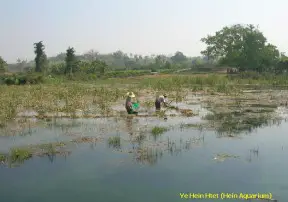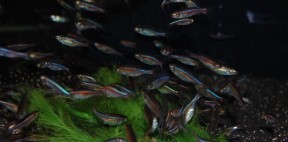Microrasbora cf. rubescens
Flame Red 'Rasbora'
Etymology
Microrasbora: Microdevario: from the Ancient Greek μικρός (mikrós), meaning ‘small’, and the generic name Rasbora, in allusion to the small size of this genus and its superficial similarity to the Rasbora grouping.
Classification
Order: Cypriniformes Family: Cyprinidae
Distribution
This fish is collected alongside Celestichthys margaritatus which was initially thought restricted to a single locality around 1,040 m AMSL near the town of Hopong in Shan State, eastern Myanmar, but is now known to occur in waters associated with the Salween (aka Thanlwin) River throughout southern Shan and even across the border in northern Thailand.
It is unclear if M. cf. rubescens shares the same pattern of distribution but it is certainly feasible.
Habitat
The type locality of C. margaritatus is an area of permanently-flooded grassland formed by the damming of a spring for agricultural purposes. The water is only around 30 cm deep, transparent and supports dense growths of aquatic plants, mostly from the family Hydrocharitaceae which includes such genera as Elodea, Egeria and Blyxa.
Other sympatric species included Devario sondhii, an undescribed Petruichthys known to aquarists as the ‘rosy’ loach, and Channa harcourtbutleri. From images most of the the other habitats look broadly similar, i.e., shallow areas of wetland surrounded by open grassland, though at least one population was supposedly discovered in ‘deep forest’.
Maximum Standard Length
30 – 40 mm.
Aquarium SizeTop ↑
Base dimensions of 60 ∗ 30 cm or equivalent are recommended.
Maintenance
Best maintained in a densely-planted tank and is an excellent choice for the carefully-aquascaped set-up.
Filtration should be relatively gentle, while the addition of some floating plants and driftwood roots or branches to diffuse the light entering the tank also seems to be appreciated.
Water Conditions
Temperature: 20 – 26 °C
pH: 6.5 – 7.5; a value of 7.3 was recorded at the habitat near Hopong.
Hardness: The water in northern Myanmar is typically soft so aim for somewhere within the range 18 – 179 ppm.
Diet
Likely to feed on small invertebrates, algae and other zooplankton in nature.
Newly-imported specimens are often in poor condition and can be difficult to acclimatise to aquarium life. Small live foods are therefore recommended as an initial diet with dry and frozen products being introduced as the fish become settled.
Behaviour and CompatibilityTop ↑
Likely to be intimidated or outcompeted for food by larger or more boisterous tankmates, although the presence of similarly-sized, surface-dwelling species seems to help reduce its shyness.
Other small fishes from Myanmar such as Celestichthys choprae, Brachydanio aesculapii, B. nigrofasciatus, Pethia phutunio, Acanthocobitis zonalternans, Petruichthys, and Akysis spp. make excellent companions, and we suspect it might also do well alongside some species not normally recommended for community aquaria such as Parambassis lala, Dario hysginon, or D. sp. ‘Myanmar’.
The closely-related Microrasbora rubescens is not recommended as these two may be capable of hybridisation.
It is a shoaling species by nature and a group of at least 8-10 specimens should be purchased. Maintaining it in decent numbers will not only make the fish less nervous but result in a more effective, natural-looking display. Males will also display their best colours and some interesting behaviour as they compete with one other for female attention.
Sexual Dimorphism
Mature females are usually deeper-bodied and noticeably larger than the more compact, intensely-coloured males.
Reproduction
Possibly unrecorded but recommendations for M. rubescens are as follows:
Like many small cyprinids this species scatters eggs randomly, typically among aquatic vegetation, and does not exhibit parental care. If the fish are in good condition they will spawn often and in a mature planted aquarium it is possible that small numbers of fry may start to appear without intervention.
However if you want to increase the yield a slightly more controlled approach is required. The adult group can still be conditioned together but one or more smaller containers should also be set up and filled with aged water. Fill much of the available space with fine wool mops, Taxiphyllum or other fine-leaved plant. Neither lighting nor filtration is necessary although a small air-powered sponge filter can be installed if you prefer.
When the adults are suitably-conditioned a single pair or group comprising several males and females is then introduced to each container; the more individuals involved the greater probability of egg predation. Males may also distract one another from females if several are present
Spawning normally presents few problems with around 30 mildly adhesive eggs deposited in a typical event. The adults are best removed post-spawning as they will eat any eggs or fry they find. Incubation is temperature-dependent to an extent but normally around 72-96 hours with the young free-swimming 1-2 days later. Initial food should be 5-50 micron grade, introducing Artemia nauplii, microworm, etc., once the fry are large enough to accept them.
NotesTop ↑
This is possibly an undescribed species and has been marketed as ‘Asian Cardinal Rasbora’, M. sp. ‘rose blue line’ or M. ‘thuzari’ in the ornamental trade.
It differs from M. rubescens by its larger adult size, possession of a greenish to bluish lateral stripe, and lesser extent of orange pigmentation on the body. It also appears to represent a distinct genetic lineage (Collins et al., 2012).
Devario sondhii can also appear comparable at first glance but orange pigmentation is restricted to the rear, ventral portion of the body and it possesses a dark cleithral spot just behind the gill plate. Devario acuticephala is also broadly similar in patterning but of Indian origin and it possesses a rough-edged, dark stripe extending laterally from the caudal peduncle along the majority of the body.
The genus has undergone a number of systematic changes in recent years but currently contains only M. rubescens. A phylogenetic study by Fang et al. published in 2009 revealed that other species formerly included in the grouping are more closely allied with Devario and reclassified them as members of new genus Microdevario, further separated from Microrasbora by differences in some aspects of internal morphology.
M. rubescens was also found to be closely related to Devario and the authors conclude that ‘its status as a valid genus is contentious and the molecular data suggest inclusion or close relationship with Devario‘. The two were not synonymised because, unlike those species moved into Microdevario, M. rubescens does not share any derived morphological characters with Devario and in the tests performed the precise level of relatedness between the two could not be settled upon.
The evolutionary pathway leading to small adult size in Microrasbora has been referred to as miniaturisation, characterised by sexually mature adults with a significantly reduced size of less than 20 mm SL. Among bony fishes cyprinids are one of the few groups in which this phenomenon occurs repeatedly across numerous genera. Most show a preference for still or slow-moving, often nutrient-poor, habitats such as forest peat swamps.
References
- Annandale, N., 1918 - Records of the Indian Museum (Calcutta) 14: 33-64
Fish and fisheries of the Inlé Lake. - Collins R. A., K. F. Armstrong, R. Meier, Y. Yi, S. D. J. Brown, R. H. Cruickshank, S. Keeling, and C. Johnston, 2012 - PLoS ONE 7(1): e28381
Barcoding and border biosecurity: identifying cyprinid fishes in the aquarium trade. - Fang, F., M. Norén, T. Y. Liao, M. Källersjö, and S. O. Kullander, 2009 - Zoologica Scripta 38(1): 1-20
Molecular phylogenetic interrelationships of the south Asian cyprinid genera Danio, Devario and Microrasbora (Teleostei, Cyprinidae, Danioninae). - Liao, T. Y., Kullander, S. O., and F. Fang, 2009 - Zoologica Scripta 39(2): 155-176
Phylogenetic analysis of the genus Rasbora (Teleostei: Cyprinidae). - Rüber, L. , M. Kottelat, H. H. Tan, P. K. L. Ng, and R. Britz, 2007 - BMC Evolutionary Biology London 7: 1-10
Evolution of miniaturization and the phylogenetic position of Paedocypris, comprising the world's smallest vertebrate.






